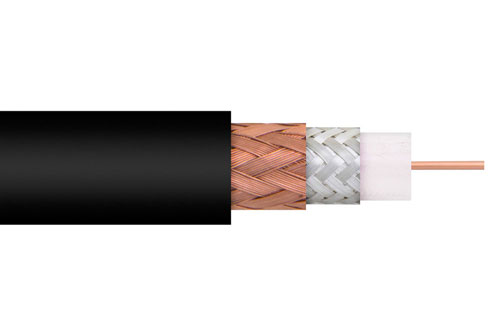
RG6 Coax Cable
RG is short for “Radio Guide” and its origins date back to World War II where the use of coaxial cable in military applications began to rise. Now the original RG specifications from the military have become obsolete, but RG designations are still used today. An example of this is RG6 coaxial cable , and the RG6 variants, such as 75 Ohm Flexible RG6 Coax Cable and 93 Ohm Flexible RG62 Coax Cable. RG6 cable is commonly used for satellite signal transmission, such as with satellite television, in residential and some commercial installations. RG6 cable is also used for television signals and internet to residential locations.
RG6 coaxial cables typically have an 18 AWG center conductor and one or more layers of braided copper/aluminum or plated copper shielding. This type of coax may also have a steel center conductor coated with copper, as they aren’t generally designed to carry high power signals and this construction results in a lower cost cable. These cables are designed to be relatively flexible and easy to install in tight locations with limited access. Other RG6 construction methods include multiple layers of shielding, solid or stranded center conductors, added foil shields, and various dielectric materials including solid and nitrogen-injected PE foam. Tolerances for RG6 also vary widely based on construction and quality.
RG62, an RG6 variant, is a 93 Ohm characteristic impedance coaxial cable that is often used for video, antenna interconnect, and broadcast applications due to the relatively low loss and low capacitance per unit length of the cable. This makes these cables suitable for longer runs with minimal loss. Like 75 Ohm Coaxial Cables, these cables are less common than 50 Ohm cables for many RF applications, but are still used in broadcast, TV, satellite, and other applications that prioritize low-loss per unit length over power handling. The higher impedance coaxial cable tends to exhibit lower per unit length capacitance. This is why 93 ohm, and 75 ohm coaxial cables are still commonly used in applications that are more sensitive to degradation from high capacitance interconnect. These applications include mostly analog video and communications, as analog signals tend to be more susceptible to degradation from slewing.
Some early internet, networking, and video applications still use 93 ohm and 75 ohm coaxial interconnect. Hence, many legacy applications still require these coaxial cables, and newer systems designed to be compatible with these legacy systems will also likely require 93 Ohm and 75 Ohm coaxial cables.




 Pasternack Blog
Pasternack Blog
